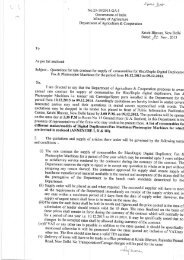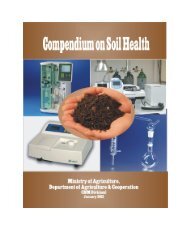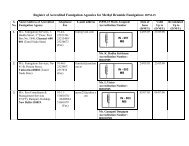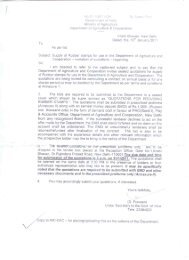canopy management in fruit crops - Department of Agriculture & Co ...
canopy management in fruit crops - Department of Agriculture & Co ...
canopy management in fruit crops - Department of Agriculture & Co ...
You also want an ePaper? Increase the reach of your titles
YUMPU automatically turns print PDFs into web optimized ePapers that Google loves.
28<br />
Canopy Management <strong>in</strong> Fruit Crops<br />
Citrus<br />
Citrus trees typically have 3-5 growth flushes a year depend<strong>in</strong>g on grow<strong>in</strong>g<br />
conditions. Each new growth flush is added onto the previous growth flush,<br />
result<strong>in</strong>g <strong>in</strong> a drift <strong>of</strong> young bear<strong>in</strong>g wood to outsides <strong>of</strong> tree <strong>canopy</strong>. Over the time,<br />
this results <strong>in</strong> larger trees with <strong>in</strong>creased shad<strong>in</strong>g <strong>in</strong>side the <strong>canopy</strong>, develop<strong>in</strong>g<br />
most <strong>of</strong> the <strong>fruit</strong>s on the tops and outsides <strong>of</strong> trees.<br />
Most <strong>of</strong> the <strong>fruit</strong>s <strong>in</strong> Citrus are born on foliage about 90 cm along from centre<br />
where light is adequate for <strong>fruit</strong> bud formation, while <strong>in</strong>side area is occupied ma<strong>in</strong>ly<br />
by support<strong>in</strong>g structure without <strong>fruit</strong>s.<br />
Growth rates are highly variable depend<strong>in</strong>g on climate, cultural practices, tree<br />
spac<strong>in</strong>g, scion, and rootstock. Younger trees (approximately 5–10 years old) have<br />
higher growth rate <strong>in</strong> relation to tree size. Once the tree reaches desired height,<br />
annual prun<strong>in</strong>g may be required to ma<strong>in</strong>ta<strong>in</strong> the height, th<strong>in</strong> the growth, and<br />
promote prolific <strong>fruit</strong><strong>in</strong>g. Maximum <strong>fruit</strong>s are set on wood that is less than 2 years<br />
old. Prun<strong>in</strong>g is least damag<strong>in</strong>g to tree yields when done on a regular basis to wood<br />
on the outside <strong>of</strong> the <strong>canopy</strong>.<br />
Prun<strong>in</strong>g is done when trees are young to establish their basic shape and cont<strong>in</strong>ues<br />
as trees mature. In commercial orchards, prun<strong>in</strong>g facilitates normal daily operations,<br />
<strong>in</strong>creas<strong>in</strong>g the yield. Where trees have outgrown their allotted space, prun<strong>in</strong>g can<br />
<strong>in</strong>crease the bear<strong>in</strong>g surface. Trees that grow too close together shade out the lower<br />
<strong>canopy</strong> portions and, <strong>in</strong> return, decrease <strong>fruit</strong> sett<strong>in</strong>g. If pruned to allow light to<br />
reach the top and lower sides <strong>of</strong> tree, the <strong>in</strong>creased bear<strong>in</strong>g surface results <strong>in</strong> <strong>fruit</strong><br />
sett<strong>in</strong>g. Any sprouts aris<strong>in</strong>g from rootstock (i.e. from below the graft union) should<br />
be removed.

















